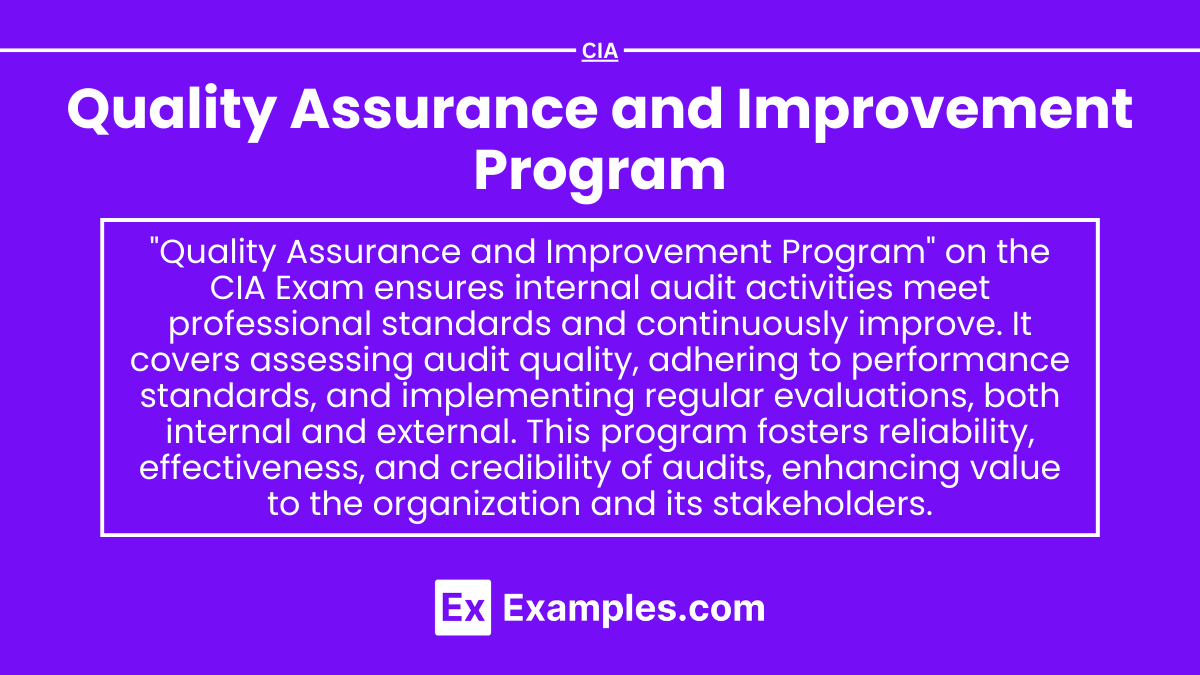Preparing for the CIA Exam demands a thorough grasp of the “Quality Assurance and Improvement Program” (QAIP), a pivotal aspect of internal audit frameworks. Mastery of QAIP principles ensures that audit activities align with global standards and are continuously enhanced. This knowledge is crucial for maintaining the effectiveness and reliability of internal audit functions, essential for achieving a high score on the CIA Exam.
Learning Objective
In studying the “Quality Assurance and Improvement Program” (QAIP) for the CIA Exam, you should learn to understand the key components and importance of QAIP within internal auditing. Analyze how QAIP ensures that audit activities meet or exceed industry standards and are conducted efficiently and effectively. Evaluate the elements such as internal assessments, external assessments, and continuous monitoring. Additionally, explore how implementing and maintaining a robust QAIP enhances the credibility and value of the internal audit function in organizations. Apply your understanding to evaluate case studies and hypothetical scenarios in your exam preparation, ensuring a deep comprehension of QAIP’s application in real-world contexts.
Introduction to Quality Assurance and Improvement Program (QAIP)
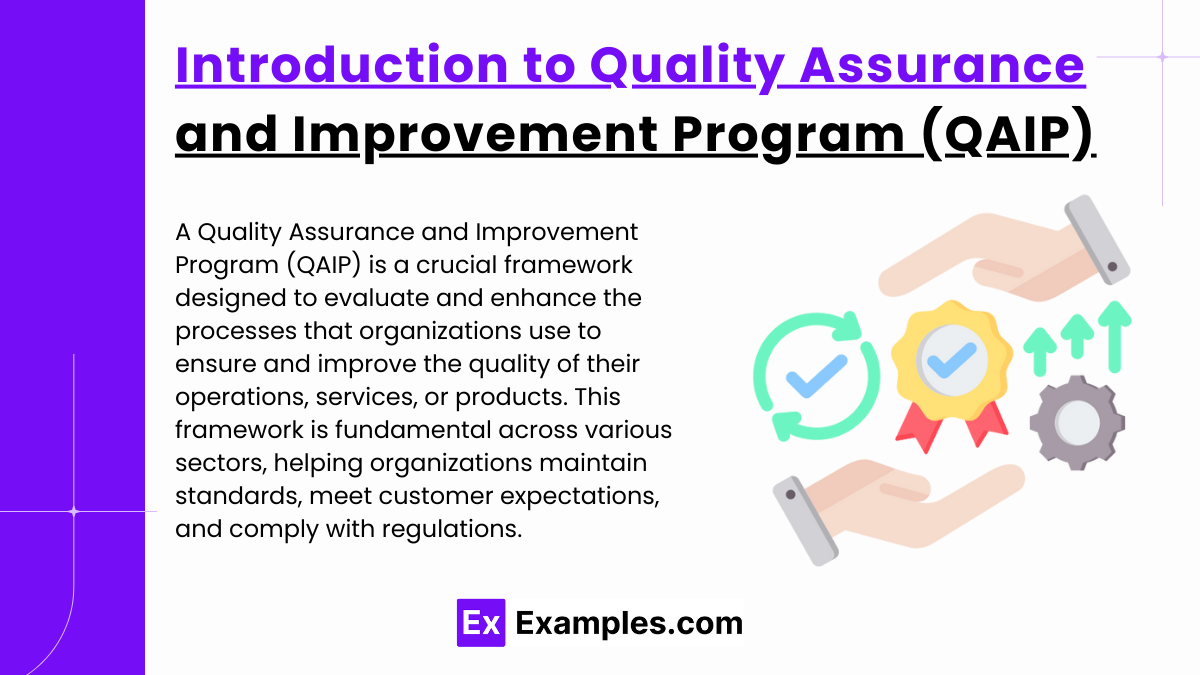
A Quality Assurance and Improvement Program (QAIP) is a crucial framework designed to evaluate and enhance the processes that organizations use to ensure and improve the quality of their operations, services, or products. This framework is fundamental across various sectors, helping organizations maintain standards, meet customer expectations, and comply with regulations. Here’s an introduction to the concept QAIP:
Purpose of QAIP
The main goal of a QAIP is to assure stakeholders that the organization’s internal processes are operating effectively and that continuous improvements are being made. This assurance comes from systematic reviews and adjustments based on feedback and performance analysis. A QAIP helps in:
- Ensuring compliance with industry standards and regulatory requirements.
- Continuously improving operational effectiveness and efficiency.
- Enhancing customer satisfaction through consistent delivery of quality services or products.
Implementation of QAIP
Implementing a QAIP involves several steps that typically begin with defining clear quality objectives aligned with the organization’s strategic goals. It also requires the establishment of a structured process for regular assessments, including internal audits and external evaluations. Training and development for staff are essential to equip them with the necessary skills to contribute effectively to quality assurance activities.
Components of QAIP
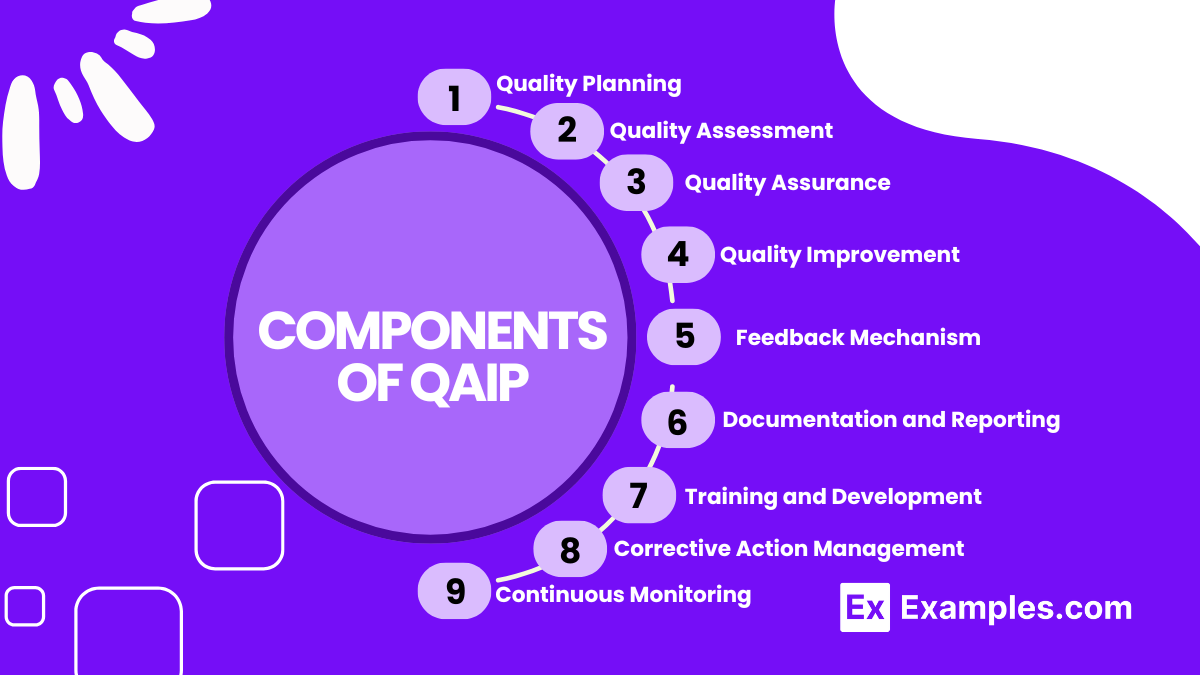
A Quality Assurance and Improvement Program (QAIP) is structured to ensure the effectiveness and continuous enhancement of quality within an organization. Here are the critical components that make up a comprehensive QAIP:
1. Quality Planning
- Objective: Establish clear, measurable quality goals aligned with the organization’s strategic objectives.
- Process: Identify key quality metrics, standards, and benchmarks to guide the QAIP.
2. Quality Assessment
- Objective: Regularly evaluate the effectiveness and compliance of existing processes, services, or products.
- Process: Conduct internal audits, peer reviews, and external assessments to identify areas for improvement.
3. Quality Assurance
- Objective: Ensure that processes and outcomes meet or exceed established standards.
- Process: Implement standard operating procedures, training, and continuous monitoring to maintain quality levels.
4. Quality Improvement
- Objective: Continuously enhance the quality of processes and outputs.
- Process: Use feedback from quality assessments to make informed improvements, adopting new technologies, methods, and practices as necessary.
5. Feedback Mechanism
- Objective: Engage stakeholders in the QA process to gather diverse insights and assessments.
- Process: Collect and analyze feedback from employees, customers, and other stakeholders to refine and improve quality measures.
6. Documentation and Reporting
- Objective: Maintain transparency and enable tracking of quality efforts and outcomes.
- Process: Keep detailed records of QA activities, findings, and outcomes; regularly report these to management and relevant stakeholders.
7. Training and Development
- Objective: Equip staff with the necessary skills and knowledge to contribute effectively to the QAIP.
- Process: Provide ongoing education and training based on the findings of quality assessments and emerging industry trends.
8. Corrective Action Management
- Objective: Address deficiencies and non-conformities identified during quality assessments.
- Process: Develop and implement corrective actions, track their effectiveness, and make adjustments as needed.
9. Continuous Monitoring
- Objective: Ensure ongoing compliance and effectiveness of quality initiatives.
- Process: Regularly review and update QA processes, systems, and practices to adapt to internal changes and external pressures.
Standards and Frameworks Guiding QAIP
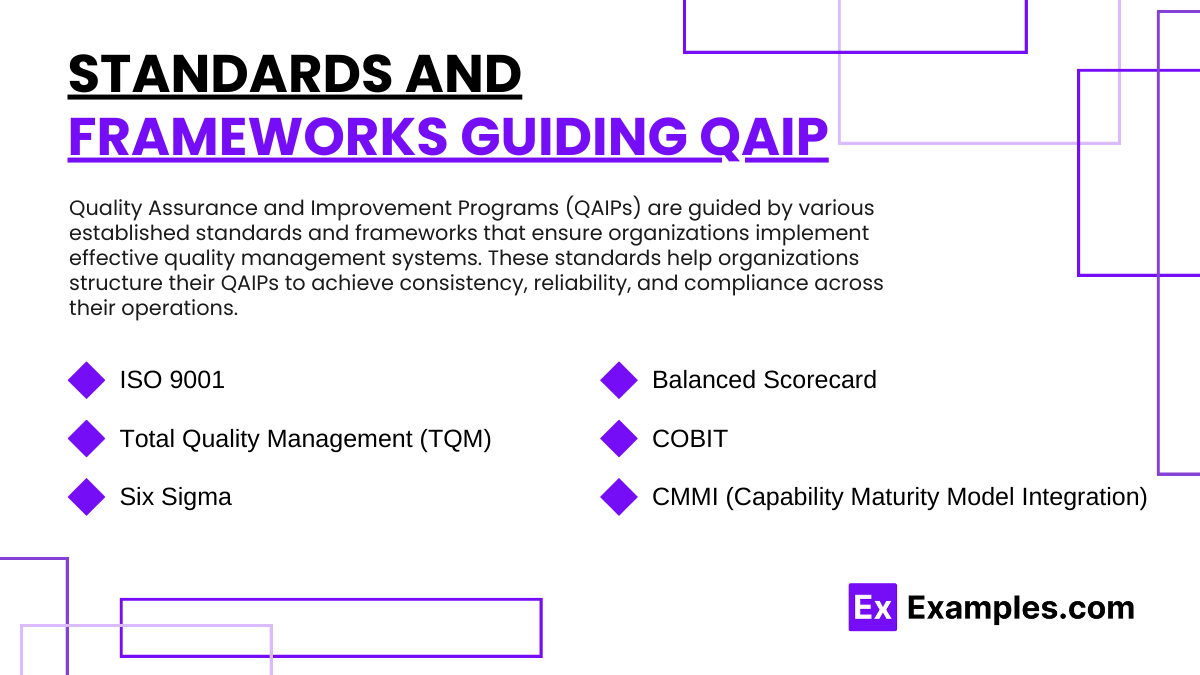
Quality Assurance and Improvement Programs (QAIPs) are guided by various established standards and frameworks that ensure organizations implement effective quality management systems. These standards help organizations structure their QAIPs to achieve consistency, reliability, and compliance across their operations. Here are some of the key standards and frameworks that play a crucial role in guiding QAIPs:
1. ISO 9001
- Focus: Comprehensive quality management to meet customer and regulatory needs.
- Application: Implements a process approach based on continual improvement and customer satisfaction.
2. Total Quality Management (TQM)
- Focus: Organizational management to improve quality continuously.
- Application: Involves all employees, focusing on long-term success through customer satisfaction.
3. Six Sigma
- Focus: Reducing defects and improving process efficiency.
- Application: Employs statistical methods and a structured approach to problem-solving.
4. Balanced Scorecard
- Focus: Strategic planning and performance management.
- Application: Measures performance in four key areas: financial, customer, internal processes, and learning & growth.
5. COBIT
- Focus: IT management and governance.
- Application: Aligns IT goals with business objectives, ensuring effective IT governance.
6. CMMI (Capability Maturity Model Integration)
- Focus: Process improvement and capability maturity model.
- Application: Helps organizations improve their performance by defining clear and measurable objectives.
Practical Applications and Case Studies
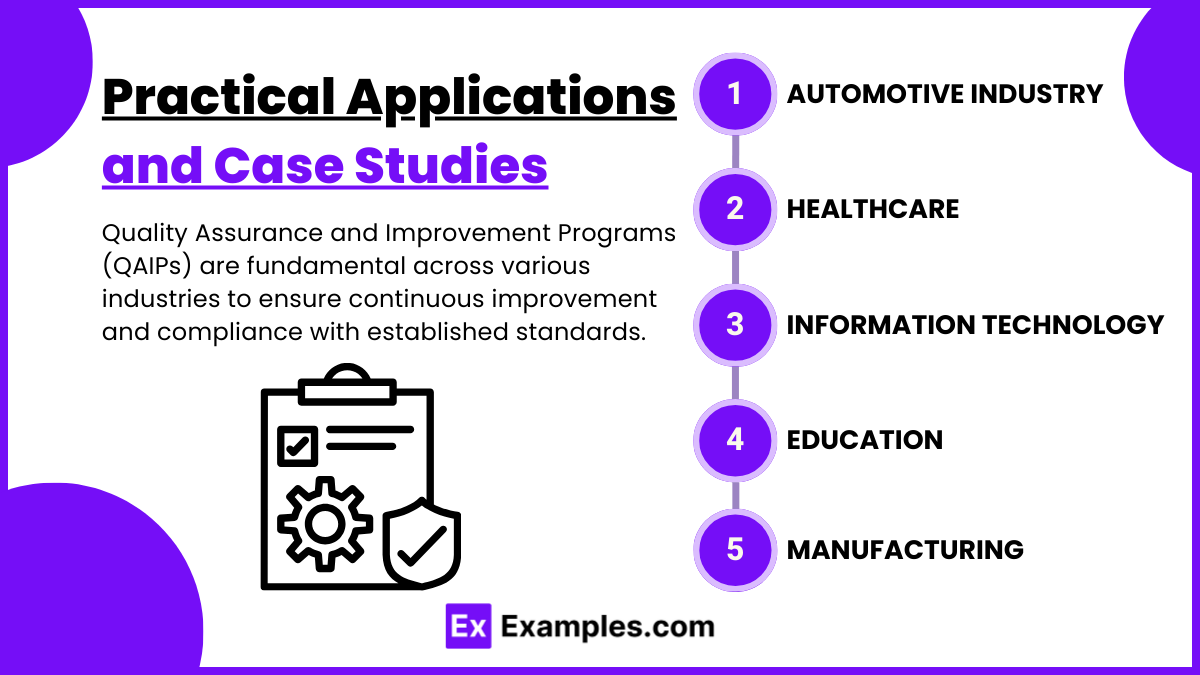
Quality Assurance and Improvement Programs (QAIPs) are fundamental across various industries to ensure continuous improvement and compliance with established standards. Here are practical applications and case studies that illustrate the impact of effective QAIPs in different sectors:
Case Study 1: Automotive Industry
- Issue: Recalls and customer dissatisfaction due to quality issues.
- Solution: Implemented Six Sigma to eliminate manufacturing defects.
- Outcome: Reduced defects, improved customer satisfaction, and lower costs.
Case Study 2: Healthcare
- Issue: Inconsistent patient care and safety.
- Solution: Adopted ISO 9001 standards to standardize patient care processes.
- Outcome: Enhanced patient care consistency, reduced incidents, and better outcomes.
Case Study 3: Information Technology
- Issue: Complex service management and customer satisfaction in a competitive market.
- Solution: Implemented COBIT to align IT services with business goals.
- Outcome: Improved IT service delivery and customer satisfaction.
Case Study 4: Education
- Issue: Variability in education quality and administrative services.
- Solution: Introduced Total Quality Management to engage staff in improvement efforts.
- Outcome: Increased student satisfaction and enhanced institutional reputation.
Case Study 5: Manufacturing
- Issue: High variability in product quality and customer complaints.
- Solution: Introduced a Balanced Scorecard to monitor quality and operational performance.
- Outcome: Stabilized product quality and reduced customer complaints.
Examples
Example 1: Healthcare Sector: Hospital QAIP
- Hospitals implement QAIP to monitor and improve patient care quality. These programs often include peer reviews, clinical audits, and patient feedback mechanisms. The objective is to reduce medical errors, enhance patient safety, and ensure compliance with healthcare regulations.
Example 2: Financial Services: Bank Internal Audit QAIP
- Financial institutions use QAIP within their internal audit departments to ensure that financial reporting and risk management processes are accurate and compliant with regulations like Sarbanes-Oxley or Basel III. These programs involve regular reviews by external auditors, risk assessment updates, and internal controls evaluations.
Example 3: Information Technology: Software Development QAIP
- In software development, QAIP focuses on ensuring that products meet customer expectations and industry standards before release. This is typically achieved through continuous integration systems, automated and manual testing protocols, and pre-release beta testing with end users to gather feedback and make necessary adjustments.
Example 4: Manufacturing Industry: Product Quality Assurance Program
- Manufacturers implement QAIP to oversee the entire production process, from raw materials sourcing to final product testing. Techniques such as Six Sigma and Total Quality Management (TQM) are employed to minimize defects, reduce waste, and ensure products are manufactured to predetermined specifications.
Example 5: Education Sector: University Accreditation and Quality Improvement
- Universities and colleges use QAIP to assess and enhance the quality of education and services they provide. This often involves periodic self-assessments, external reviews, student feedback surveys, and accreditation processes to ensure educational standards are met and continuously improved.
Practice Questions
Question 1
What is the primary purpose of a Quality Assurance and Improvement Program (QAIP) in an internal audit function?
A. To ensure compliance with government regulations
B. To enhance and maintain the quality of the audit activity
C. To guarantee the financial success of the organization
D. To facilitate external audits
Answer: B. To enhance and maintain the quality of the audit activity
Explanation:
The main goal of QAIP is to enhance and maintain the quality of the internal audit activity, ensuring that it continues to add value and operate effectively. While compliance with regulations (A) is important, it is not the primary purpose of QAIP. Guaranteeing the financial success of the organization (C) and facilitating external audits (D) are benefits that may arise from a well-functioning QAIP, but they do not represent its primary purpose.
Question 2
Which of the following is considered a component of an effective Quality Assurance and Improvement Program?
A. Periodic performance evaluations
B. Continuous legal consultation
C. Mandatory external staffing
D. Fixed audit schedules
Answer: A. Periodic performance evaluations
Explanation:
Periodic performance evaluations are a crucial component of QAIP, as they help in assessing the effectiveness of the audit function and identifying areas for improvement. Continuous legal consultation (B) might be beneficial but is not a standard component of QAIP. Mandatory external staffing (C) and fixed audit schedules (D) are not typically required elements of a QAIP.
Question 3
What role does an external assessment play in a Quality Assurance and Improvement Program?
A. It validates the independence of the audit function.
B. It replaces the need for internal assessments.
C. It focuses solely on financial audits.
D. It assesses compliance with industry standards.
Answer: A. It validates the independence of the audit function.
Explanation:
External assessments in a QAIP are critical as they provide an objective review and validate the independence and objectivity of the internal audit function. They do not replace internal assessments (B), as both are important for a comprehensive QAIP. External assessments are not limited to financial audits (C) and while they do assess compliance with industry standards (D), the primary role is to ensure independence and objectivity.

